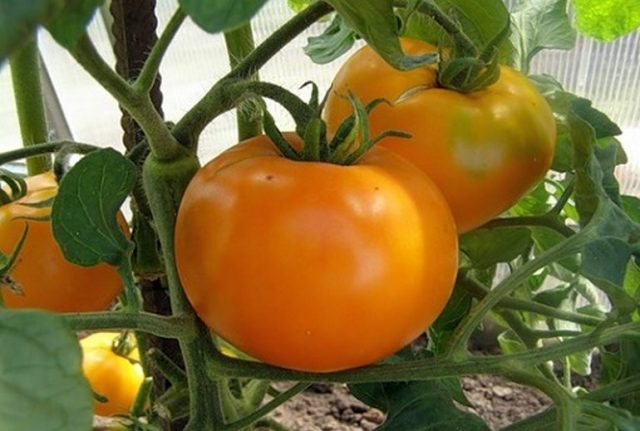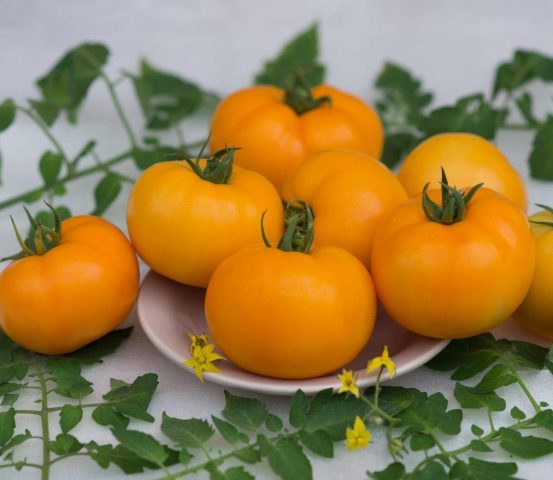Content
The Altai orange tomato has passed the variety trials and was included in the State Register. Since 2007, the gardeners of Siberia, the Krasnodar Territory and the Moscow region have fallen in love with him. The tomato is recommended for all regions of the Russian Federation. It can be grown in unheated greenhouses and open ground.
Description of tomato Altai orange
From the name it is clear that the variety was bred by Altai breeders. The originator is the agricultural company "Demetra-Siberia". There are a lot of rave reviews on the Internet on the forums, as well as photos of Altai orange tomatoes. Many praise the taste and shape of the fruit.
Tomato of this variety is indeterminate by its type of growth. The formation of flower clusters, stepchildren and the growth of the central stem continue until the end of the growing season. The height of the bushes in the open field is from 1.6 to 1.7 m, but in greenhouses the Altai orange tomato grows up to 2 m.
There are a lot of leaves and stepchildren, which complicates care. For the normal setting and ripening of fruits, it is necessary to regularly pinch and partially remove the leaves. Recommend 3 schemes for the formation of a bush:
- in one stem when all stepsons are removed;
- in 2 stems, then one stepson is left after the 4th leaf;
- in 3 stems, while leaving 2 stepsons in the 3rd and 4th sinuses.
Tomato has simple inflorescences, brushes are tied in every second bosom, the first is formed behind 9-12 leaves. Due to their high growth, the bushes need a solid support. The garter has to be carried out often: as the shoots grow, the fruits are poured.
The fruits of the Altai orange tomato reach the stage of technical ripeness in 110 days. According to the ripening period, the plant belongs to the group of mid-season varieties, the growing season of which lasts up to 115 days. The Altai orange tomato variety is propagated only by seedlings. The tomato has no restrictions on climatic zones.
Brief description and taste of fruits
The fruits of the Altai orange tomato delight gardeners. It's hard to find another strain with such good taste reviews. This is a large-fruited variety, subject to agricultural technology, it is possible to grow specimens weighing up to 700 g.
Most of the fruits weigh 250-300 g. Tomatoes are round-flattened in shape. Slightly ribbed at the junction with the peduncle. When ripe, the skin turns bright orange. Ripe tomato of Altai variety with orange color resembles an orange.
The pulp contains useful substances. It contains β-carotene, a high concentration of chloroplasts. Due to this, the Altai orange tomato variety has such a high sugar-acid index, an intense fruit taste.
It is better to use the fruits fresh. If the harvest is large, then you can process it. The best processing option is the preparation of juice. The harvest is stored for about one month. The fruits can be picked green, they ripen. The taste and appearance are not affected.
Varietal characteristics
The yield of tomatoes of this variety depends on the quality of care and the place of growth. In the greenhouse, the yield is higher. Subject to the planting scheme of 3-4 bushes per 1 m², 10 kg (3-4 kg from one bush) are harvested from the Altai orange tomato variety. In the garden, 12-15 tomatoes are formed on one plant. The size depends on the formation scheme of the bush, the quality and quantity of dressings.
The fruiting period begins early.The first tomatoes of the Altai Orange variety are harvested in early July. When planting seedlings in a greenhouse in April, the first harvest is rejoiced at the end of June. Fruiting lasts a long time. The last fruits are harvested at the end of August.
If the crop rotation is observed, the planned preventive measures are carried out, the Altai orange tomato does not get sick. Gardeners note that the tomato is resistant to verticillium, fusarium, rarely suffers from the tobacco mosaic virus.
As measures for the prevention of rot (root, apical), it is recommended to carry out preventive measures:
- monitor the purity of the soil;
- loosen the soil;
- mulch ridges;
- treat bushes with Fitosporin-M.
Insect infestations can be expected during flowering. Tomato varieties Altai orange can be threatened by:
- whitefly;
- thrips;
- spider mite;
- aphid;
- Colorado beetle;
- bear.
The beetle and the bear are collected and destroyed, the bushes are treated with an aqueous solution of ammonia. For ticks and whiteflies, insecticides are used, for aphids - an ash-soap solution and a decoction of celandine.
Pros and cons of the variety
The tomato has no obvious flaws. There are features on which the yield of the Altai orange variety depends:
- soil fertility;
- compulsory summer feeding.
The pluses include:
- taste, color, size of the fruit;
- stable yield;
- standard, uncomplicated care;
- good adaptation to weather conditions;
- stable immunity of tomatoes of the Altai orange variety.
Planting and care rules
The description of the variety indicates that the Altai orange tomato is propagated by seedlings. The seeds are sown in March from the 1st to the 20th. By the time of transplanting into the ground, the seedlings should be fully formed. The age of high-quality seedlings is 60 days, the maximum is 65.
How to grow seedlings
Sowing seeds is carried out in a common container. Take plastic containers 15-20 cm high.Prepare the soil mixture:
- humus - 1 part;
- sod land - 1 part;
- low peat - 1 part.
Mix everything well. Fertilizers are added to 10 liters of soil mixture:
- urea;
- superphosphate;
- potassium sulfate.
Each 1 tsp.
Seedlings at a temperature of 22-25 ° C appear in 5-7 days. After the appearance of the 2nd true leaf, the seedlings dive. They are transplanted into separate glasses (bags or milk cartons). You can dive into a larger common box. In a separate container, the roots develop better, the seedlings do not get sick when transplanted into the ground.
Transplanting seedlings
Altai orange seedlings can be transplanted into the greenhouse in April or early May. The soil should warm up to 15 ° C. In cold soil, tomato seedlings stop growing and may die. The critical ground temperature is less than 10 ° C.
In open ground, the Altai orange tomato is planted in the terms adopted in the region. They depend on weather conditions. Usually, the transplant is carried out from June 1 to June 10. The holes are formed according to the scheme 50 x 40 cm. 3-4 Altai orange tomato seedlings are planted on 1 m².
Humus (8-10 kg / m²), superphosphate (25 g / m²), potassium sulfate (15-20 g), urea (15-20 g) are added to the soil. Stakes are placed immediately. Seedlings are transplanted using the transshipment method. Overgrown seedlings are planted at an angle. Tied to the stakes immediately or after 5-10 days.
Tomato care
Watering the bushes begins 10-14 days after transplanting the seedlings into the ground. She has taken root by this time. The roots start to work. In the greenhouse, tomatoes are watered more often (1 time in 3 days), where the earth dries out faster. In the garden, the Altai orange tomato is watered according to the weather. If there is no rain, then once every 5 days.
The stepsons pinch as they appear. They do not allow them to stretch more than 5 cm. To obtain large tomatoes, lead the tomato into one stem. If the goal is to grow more fruits, then the formation scheme is chosen in two, less often in 3 stems.
Passion-picking is carried out weekly.This allows you to keep the bushes in good condition. After the formation of fruits in the lower brushes, the lower leaves are removed. This procedure is mandatory. It has 3 goals:
- Improve the lighting of the bush.
- To direct the forces of the plant to the formation of fruits.
- Normalize the moisture level in the root zone.
Tomatoes love it when air circulates freely between the bushes. The fruit sets better. Tomatoes are less likely to get sick with fungal diseases. Altai orange tomato responds well to root and foliar feeding. During the season, they must be carried out at least 3 times:
- the first, when buds are formed in the first brush, fertilize with mullein infusion;
- the second, when ovaries are formed in the second brush, use nitroammophoska, superphosphate, ash;
- the third, during active fruiting, is fed with potassium monophosphate to accelerate ripening.
During the period when the ovaries are formed, the Altai Orange tomato bushes are fed with complex preparations for tomatoes: "Tomaton", "Ovary", "Sudarushka". They contain trace elements. Root dressing is carried out after watering. Spraying on a leaf with liquid fertilizers is done in the morning or evening.
Conclusion
For 10 years, the Altai orange tomato has been tested in different regions of the country. The variety is grown in greenhouses and vegetable gardens. The yield indicators of the variety are different. Not everyone is able to remove the claimed 3-4 kg from the bush. But everyone is happy with the taste and size of the fruits.










